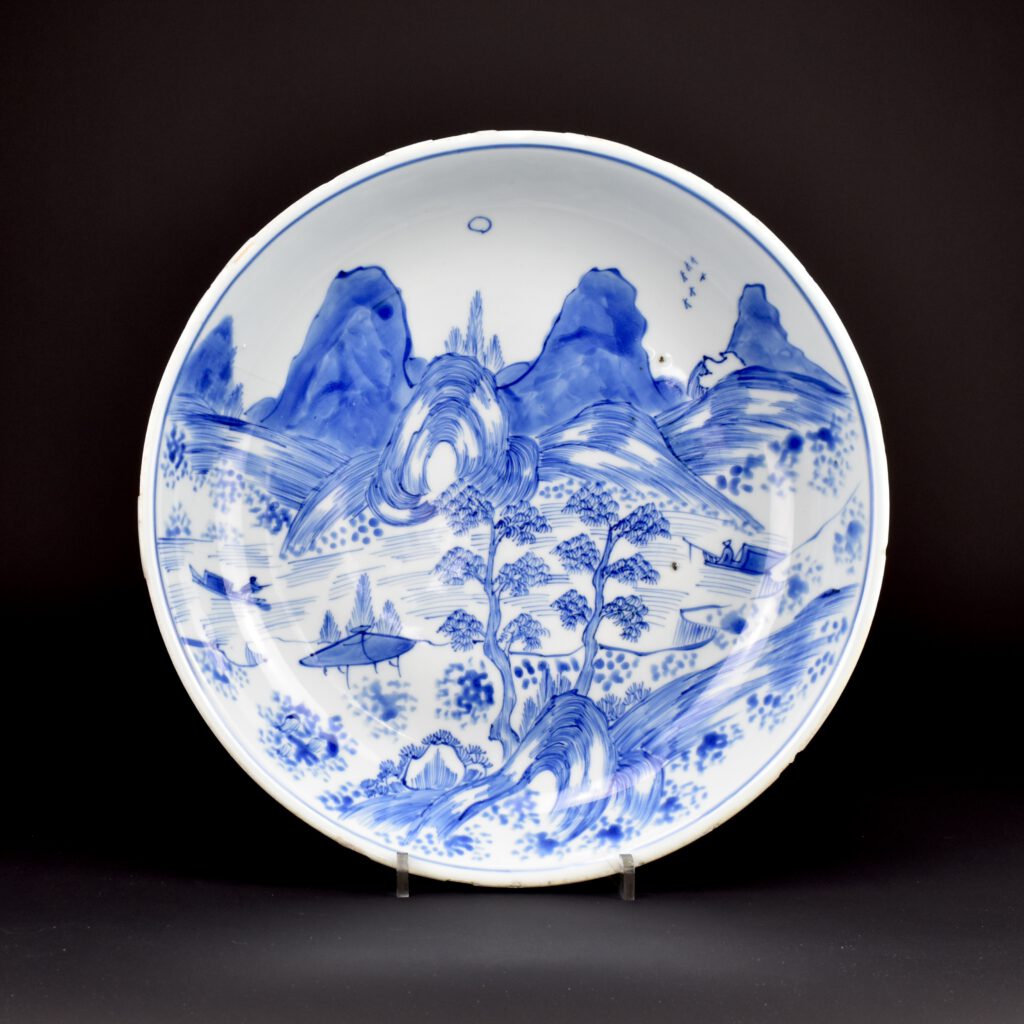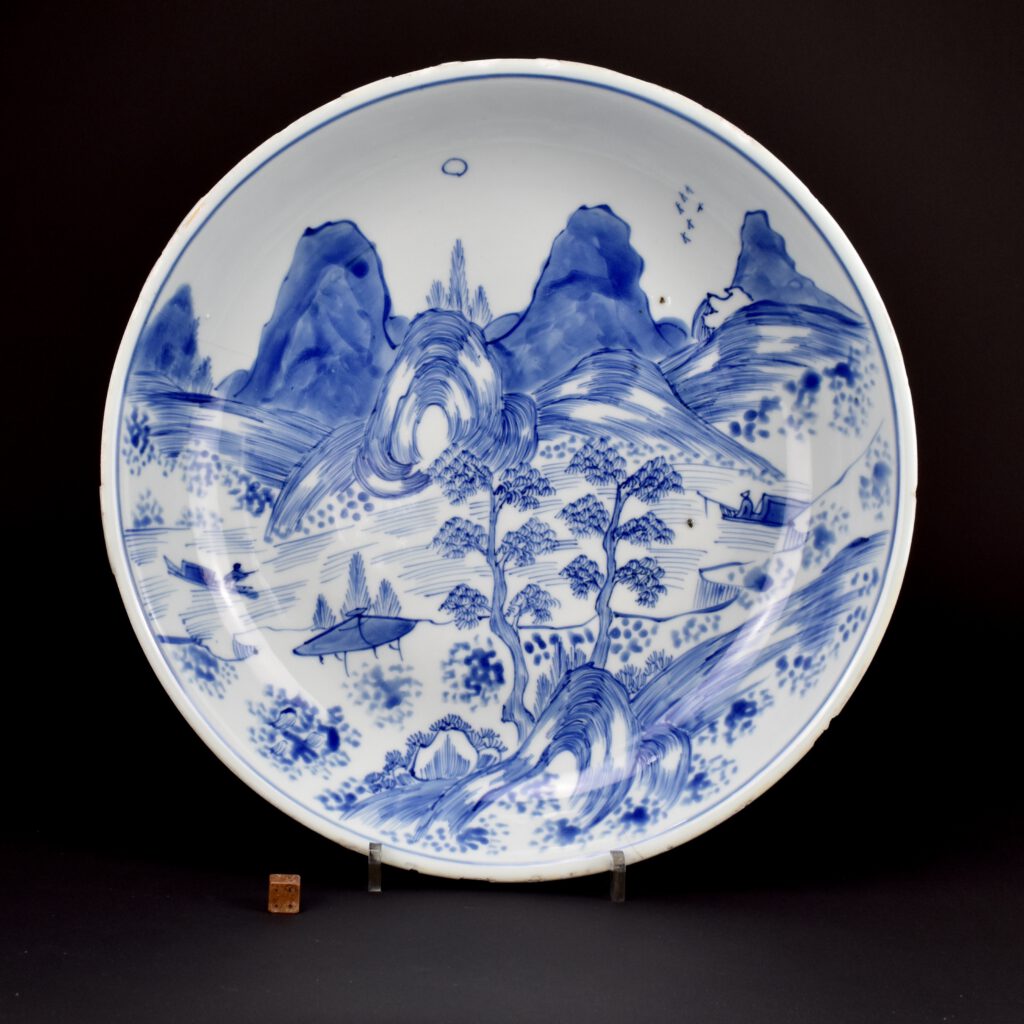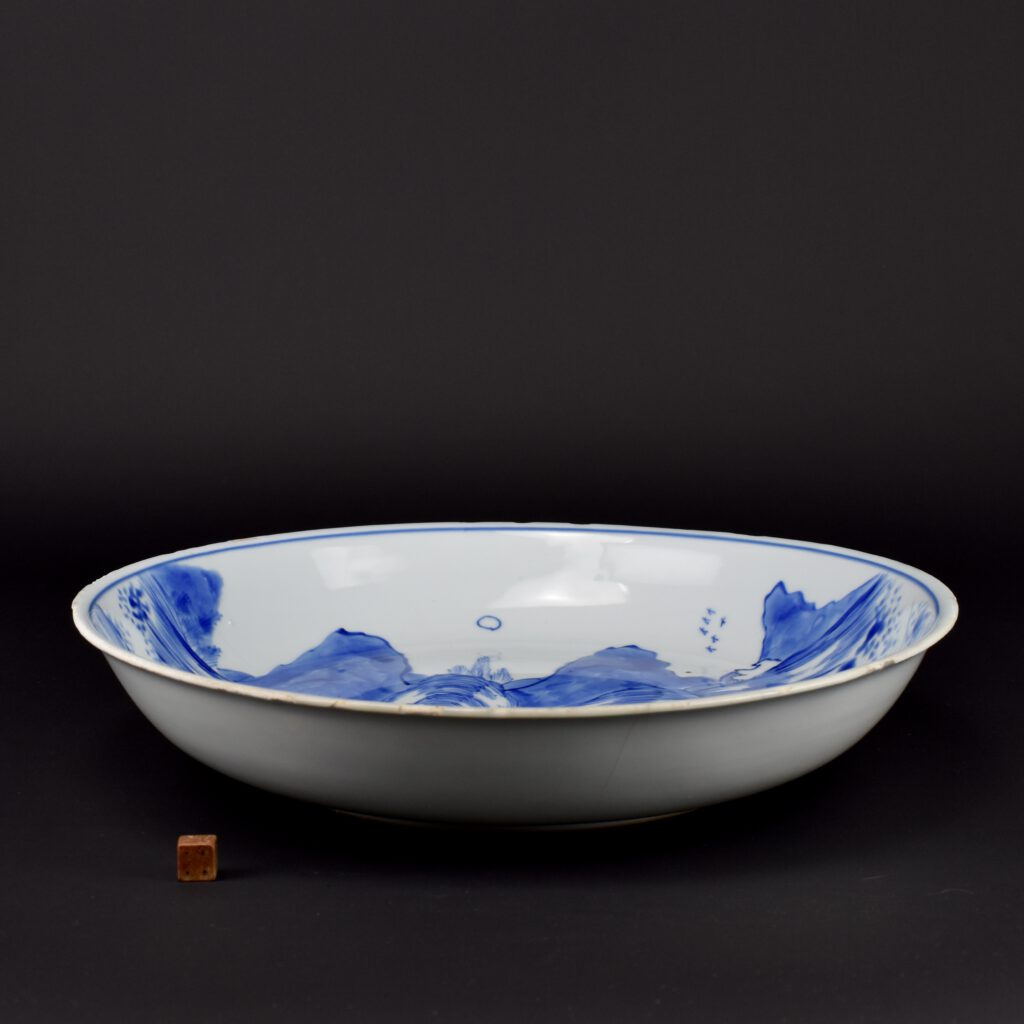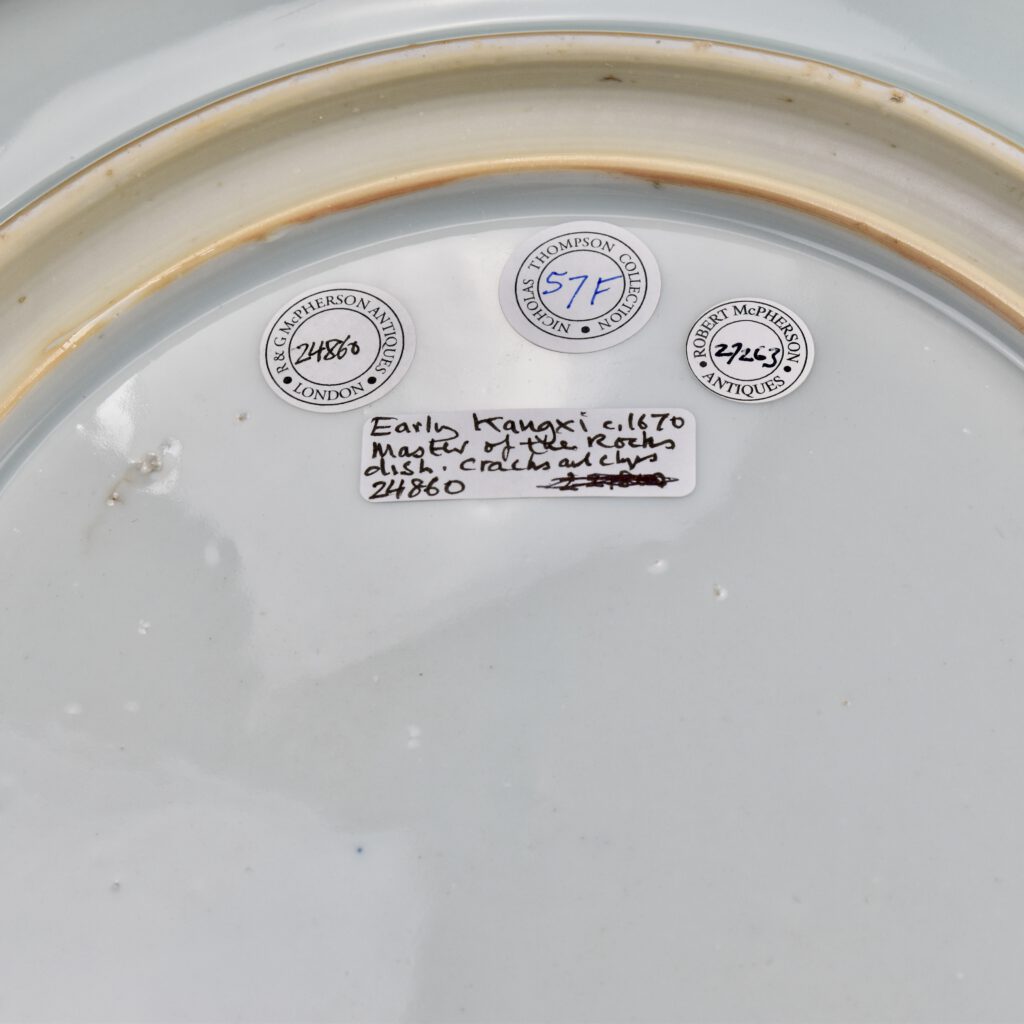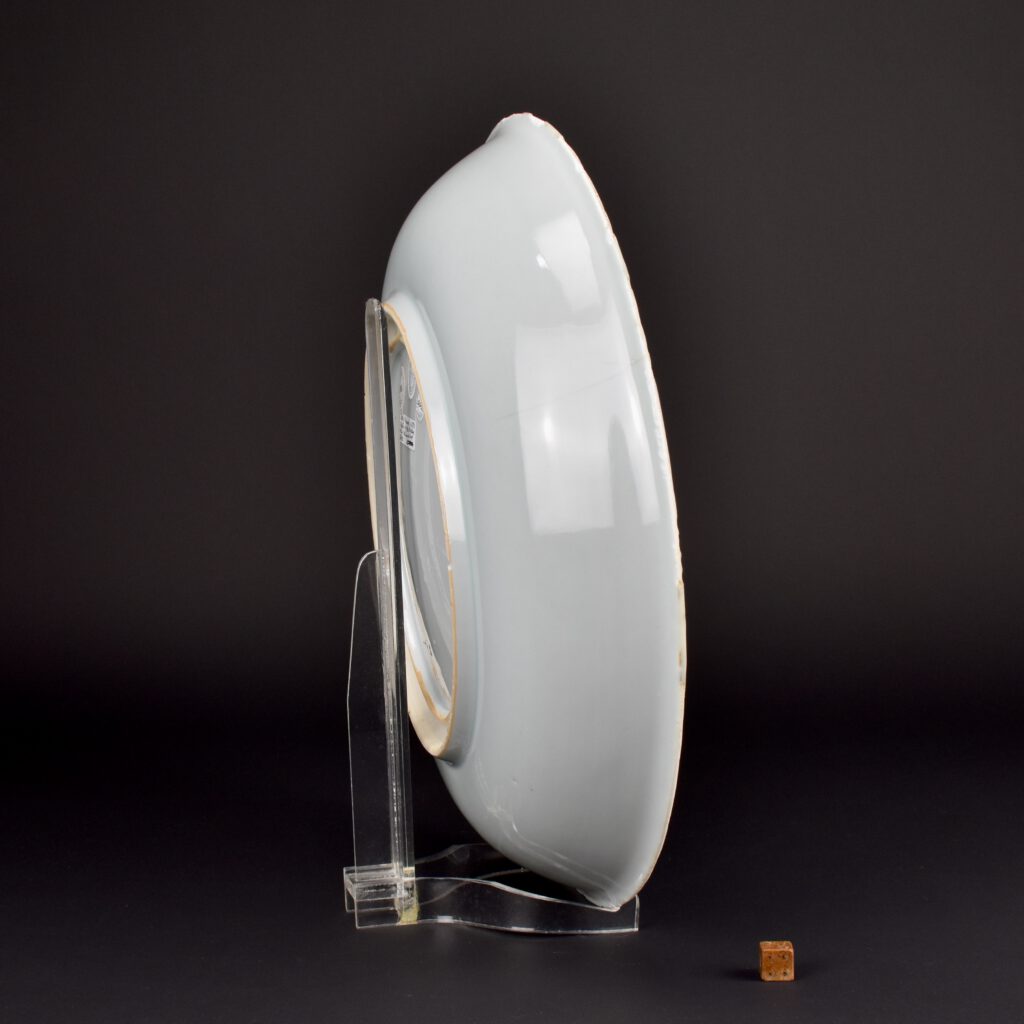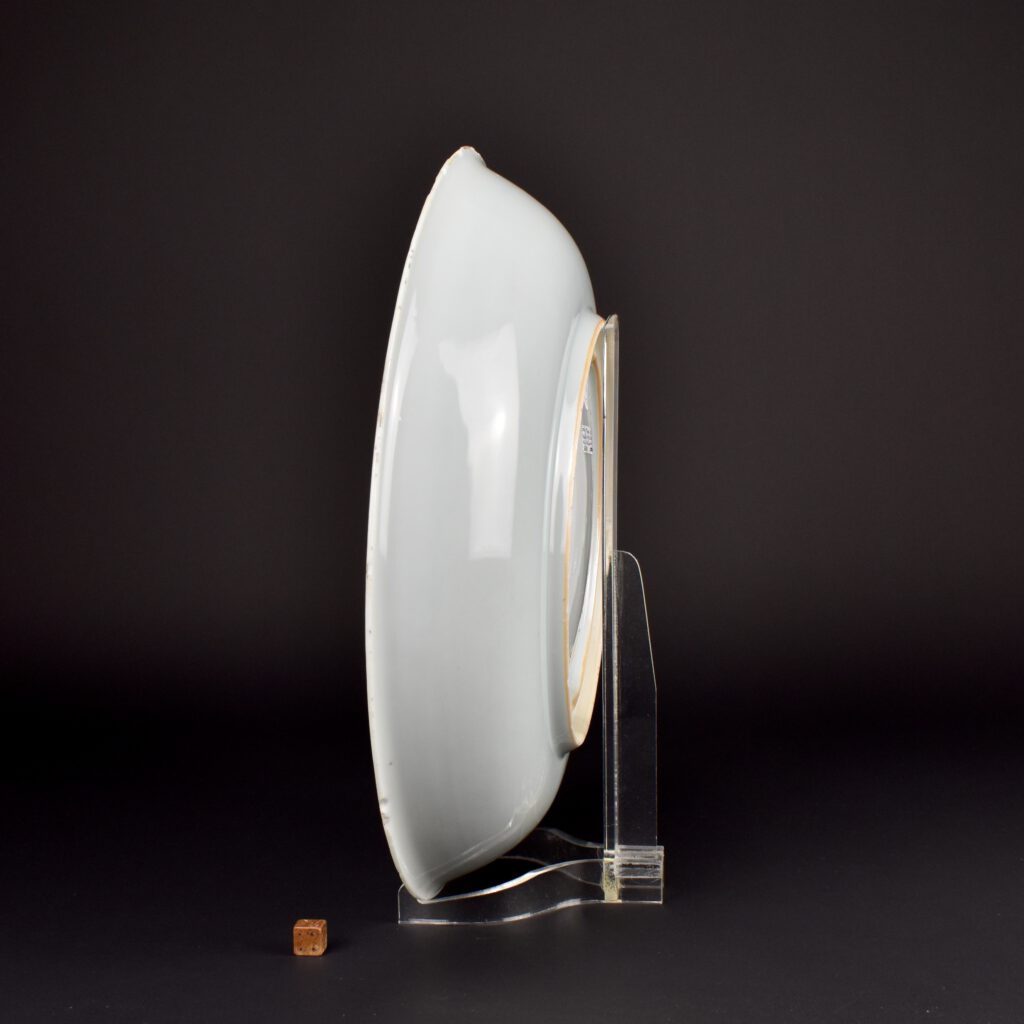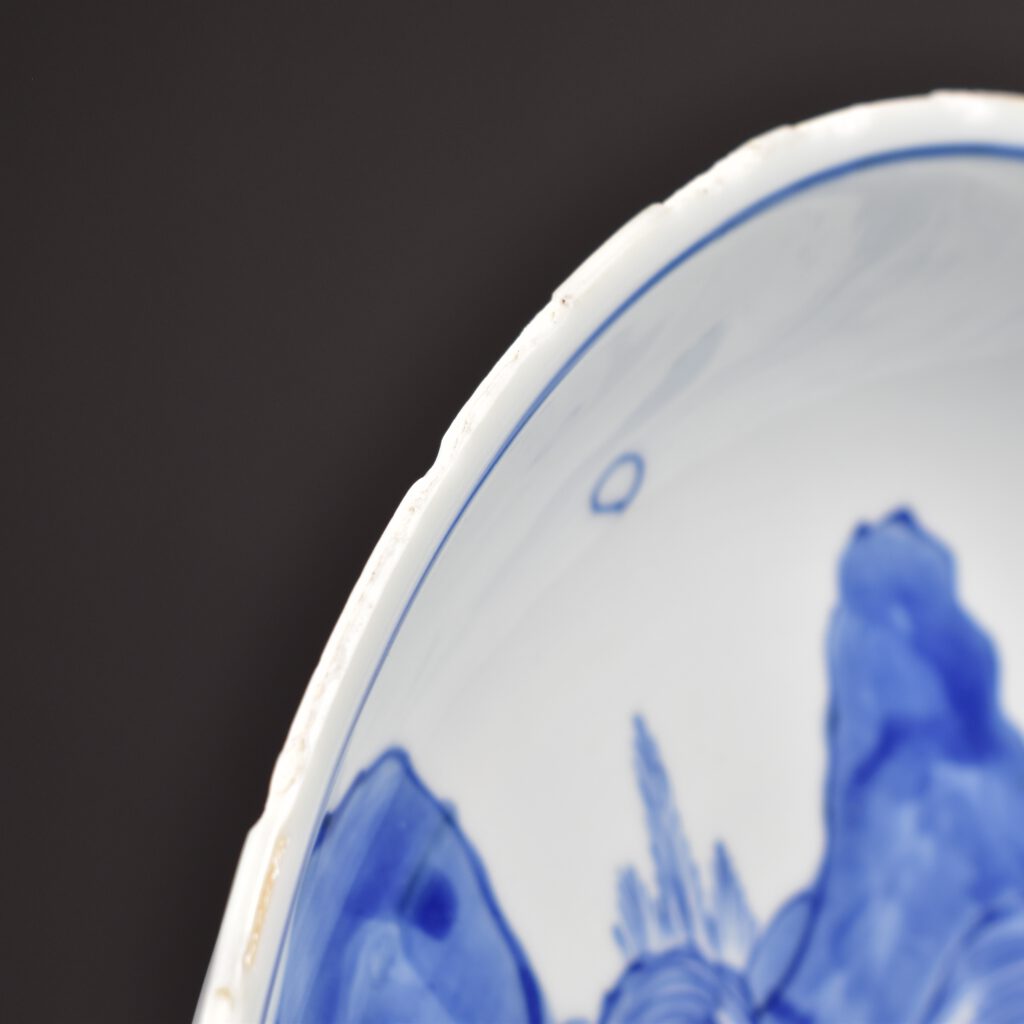
A Large Fine Early Kangxi Master of the Rocks Porcelain Dish
Large Fine Early Kangxi Master of the Rocks Porcelain Dish c.1662-1674. From Collection of Nicholas de la Mare Thompson (1928-2010). This thickly potted Blue and White Porcelain plate is painted with a typical Master of the Rocks scene of the style that was employed the earlier period c.1662-1674. The phrase Master of the Rocks is unfamiliar to many Chinese, it is another invented category used by western scholars and collectors to pigeon-hole groups of Chinese ceramics, rather like Kraak ware or Celadon. However, unlike either of these, Master of the Rocks is a clear, distinct group. It was first coined by Gerald Reitlinger, whose collection of Chinese ceramics is now in the Ashmolean Museum in Oxford. This style lasted from about 1645/1650 to the 1690s. The highly distinctive painting style consists of landscapes with massive powerful mountains in a linear technique. The style is, for want of a better word, ‘painterly’ and often includes distant mountains painted with a very wet brush with areas of tone that contrast with the linear mountains in the mid to foreground. The style usually employs a technique of ‘blobby dots’, either in the landscape or as a border, sometimes both. These dots are painted with a wet brush and have no outline. These designs were certainly inspired by late Ming scroll painters like Wang Jinazhng (active c.1628 – 1644) among others. The same use of brush strokes in contour like parallels lines, that appear in the paintings, can be seen on the porcelain. Mountains with jagged peaks are piled up creating a dramatic structure. But where as many of the scroll painters are known by name, the ceramics artists remain anonymous.
See below for more photographs and references.
SOLD
- Condition
- Damaged ; two large cracks both with an adjacent small crack, chips, small chips and fritting. For details see the Photograph Gallery below.
- Size
- Diameter 33 cm (12 1/2 inches). Depth 6.4 cm (2 1/2 inches).
- Provenance
- Almost certainly de la Mare Thompson collection, so inherited by Nicolas Thompson. Collection of Nicholas de la Mare Thompson (1928-2010) very early collection number 057. No purchase details, helping to confirm it was a family piece.
- Stock number
- 27263
- References
- A Master of the Rocks Dish from The Butler Family Collection, Sold at Christie's Hong Kong, 30th of November 2023. HKD 302,400 = £30,663. To see more details, including a photograph, look below the Photograph Gallery Below.
Information
Nicholas de la Mare Thompson (1928-2010).

Nicholas de la Mare Thompson, the grandson of the author Walter de la Mare spent his career in publishing. He started at Nesbit where he was editor of the Janet and John series of children’s books but not all of his career was so safe. He wrestled with W.H. Smith over the content of Madonna’s raunchy Sex book on behalf of Paul Hamlyn’s Octopus Group and defeated Margaret Thatcher over Spycatcher. He could not bare dogma or hypocrisy.
It was hardly surprising that as a committee member of the O.C.S. he had his own ideas. He read and could recite great swaths of the articles of the Society, he used this not to attack but to stimulate debate. He approached the Society in the same way as he approached his understanding of Chinese ceramics, by stripping it down and starting again using clear empirical thinking. He was very concerned the Society was open to all and was run for the benefit of all members.
Nicholas came from a family of collectors, his love of oriental ceramics was broad but his focus was on early monochromes, especially those from the Song dynasty. He bought what he loved, what he thought had merit, not what was said to be good, and certainly not anything because it was fashionable. He didn’t have a stamp collectors’ approach, filling in the gaps of pre-existing ordered collection, rather he would react to an object, feeling it was right for his collection. Sometimes he wasn’t sure if it was right for his collection or not. He would then “borrow” pieces and live with them, other times he would ask his wife Caroline, who’s eye he trusted, if he should keep the piece or not. He was amused because I was often able to know if he would keep a piece before he did. We discussed “pots” endlessly, he loved to talk about ceramics with a wide variety of people and enjoyed the company of others on O.C.S. trips as well as in discussion groups or anywhere else. Later on he combined his love of Chinese ceramics with his love of books by extending his library to include rare early books, he used these to trace the development of collecting and scholarship in the 19th and early 20th century. He was fascinated by earlier scholarship, what was not understood but also what they understood, and we have lost. He was always reading and wanted to know more right up to the end, he didn’t see impending death as a barrier to knowledge or indeed collecting. The week before he died he questioned, if only for a second, whether it was too late to buy another pot for the collection. He concluded it was not, he was a true collector.
Nicolas died on the 25th of April 2010 at the age of 82 after living with cancer for two years. He leaves behind his energetically supportive wife Caroline and his three children. He was a kind, gentle and incredibly civilised man with a very sharp mind and dry sense of humour, he was passionate about the Society, its aims and its members. He was an incredibly supportive and thoughtful friend and will be missed very much.
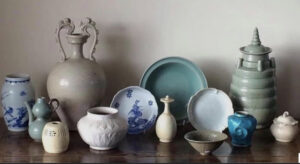
A Master of the Rocks Dish from The Butler Family Collection
Sold at Christie's Hong Kong, 30th of November 2023.
HKD 302,400 = £30,663.
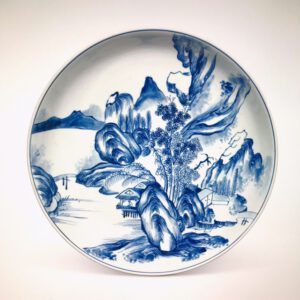
KANGXI PERIOD (1662-1722)
12 7⁄8 in. (32.5 cm.) diam.
PROVENANCE
The Butler Family Collection, UK
LITERATURE
M. Butler, B. Harrisson, and Princessehof Museum, Chinese Porcelain: The Transitional Period 1620-1683: A Selection from the Michael Butler Collection, Leeuwarden, Netherlands, 1986, p. 88, no. 105
Sir M. Butler, 'Chinese Porcelain at the Beginning of the Qing,’ Transactions of the Oriental Ceramic Society, 1984-1985, vol. 49, London, 1986, pp. 11-39, pl. 29
Sir M. Butler, M. Medley and S. Little, Seventeenth Century Chinese Porcelain from the Butler Family Collection, Alexandria, Virginia, 1990, p. 137, no. 86
T. Canepa and K. Butler, Leaping the Dragon Gate- The Sir Michael Butler Collection of Seventeenth-Century Chinese Porcelain, London, 2021, p. 407, pl. III.4.56a, b
EXHIBITED
The Princessehof National Museum of Ceramics, Leeuwarde, Netherlands, Chinese Porcelain: The Transitional Period 1620-1683: A Selection from the Michael Butler Collection, 1986
Travelling exhibition to 12 museums in the United States, Seventeenth Century Chinese Porcelain from the Butler Family Collection, 1990
The Transitional Period c.1620 – 1683 :
This is a term used in the West to describe Chinese porcelain made during the turbulent times that befell China in the 17th Century. From the disintegration of the Ming Dynasty and it`s eventual collapse in 1644 through the troubled start of a new `Foreign` Qing dynastic house. The roots of this unsettled period starts during the later part of Wanli`s reign (1573-1620). At the begging of his reign China was doing very well, new crops from the Americas such as peanuts, maize and sweet potatoes increased food production, while simplified taxes helped the state run smoothly. But this was not due to Wanli`s enlightened reign, but to his Mother championing a man that was to become the Ming dynasties most able minister, Zhang Zhuzheng (1525—1583). Wanli became resentful of Zhuzheng`s control but upon his death became withdrawn from court life. Between 1589 to 1615 he didn't appear at imperial audiences, leaving a power vacuum that was filled by squabbling ministers. Mongols from the North raided as Japan invaded Korea. Wanli re-opened the silver mines and imposed new taxes but the money was lost due to corruption, as well as being frittered away by the indulgent Emperor himself . The next emperor of Ming China, Tianqi (1621-1627), was brought up in this self indulgent disorganised environment, at the very young age 15 his short reign started. He didn't stand a chance. Tianqi made the mistake of entrusting eunuch Wei Zhongxian (1568-1627) who Anna Paludan in her excellent book “Chronicle of the Chinese Emperors” (Thames and Hudson, 1998) describes as “a gangster of the first order”. Tianqi was deemed to have lost the Mandate of heaven by the Ming people. Tianqi`s younger brother, the last of the Ming Emperors, Chongzhen (1628-1644), was not able to save the situation. The systems of administration had broken down, corruption was rife and so when a sever famine broke out in 1628 nothing much could be done. Anna Paludan describes the tragic end to the great Ming Dynasty “The final drama was worthy of a Greek tragedy. The emperor called a last council in which `all were silent and many wept`, the imperial troops fled or surrendered, and the emperor, after helping his two sons escape in disguise, got drunk and rushed through the palace ordering the women to kill themselves. The empress and Tianqi`s widow committed suicide; the emperor hacked off the arm of one daughter before killing her sister and the concubines. At dawn he laid his dragon robe aside and dressed in purple and yellow, with one foot bare, climbed the hill behind the now silent palace and hanged himself on a locust tree”. The Great Wall of China, started 2,000 years ago was built to protect China from the Northern barbarian hoards, it was often tested and sometimes failed. The Jin people invaded China, ruling the North between 1115 and 1234, it was their descendants the Manchus, Jurchens from south east Manchuria that took full advantage of the problems of the Ming dynasty. In 1636 they adopted a Chinese dynastic name, the `Great Qing` (Qing meaning pure). The first of the Qing emperors was Shunzhi (1644-1661) but for most of his reign his uncle ran the state. War raged on during this period and it wasn`t until the second Qing emperor Kangxi (1662-1722) that true peace was achieved. Kangxi was a wise and educated man, he became a highly successful emperor bringing China a long period of wealth and stability.
